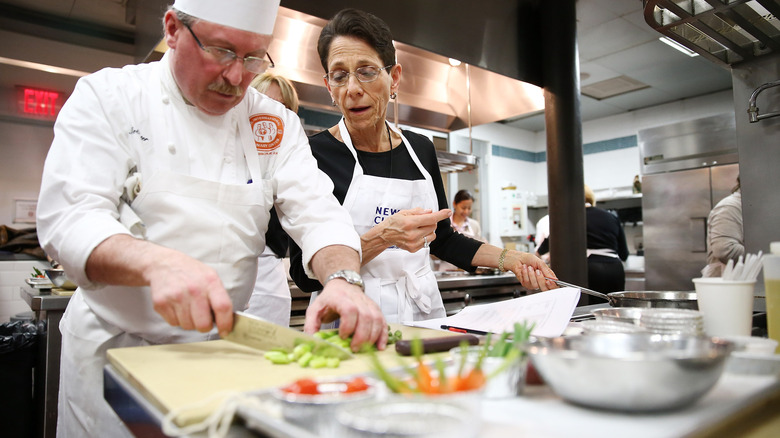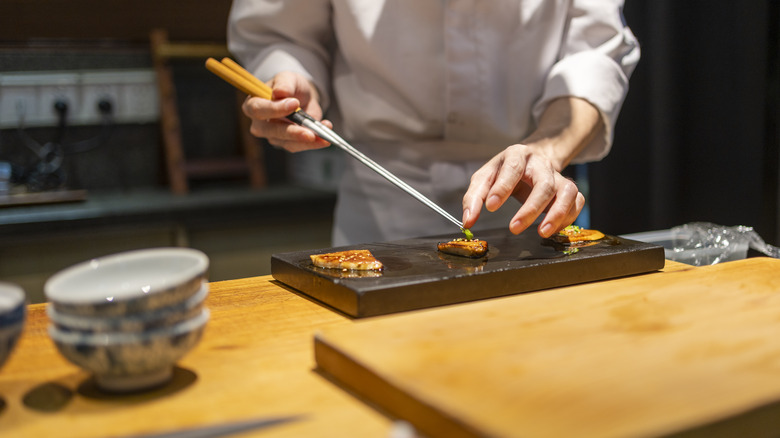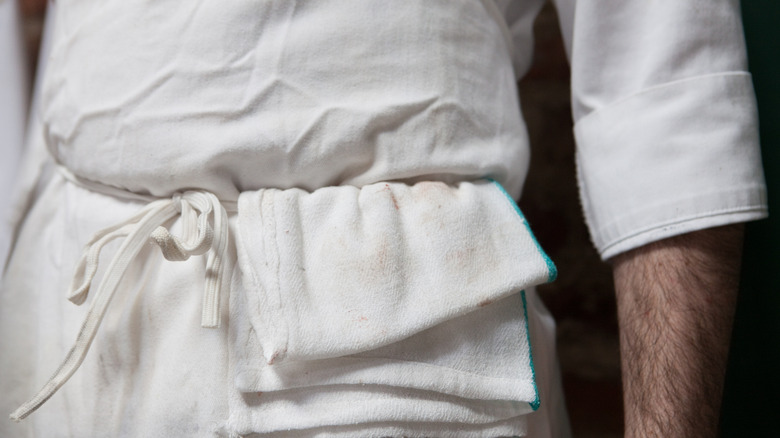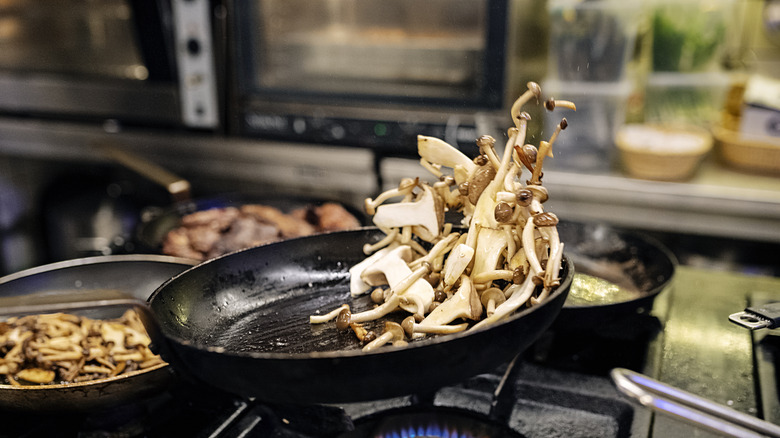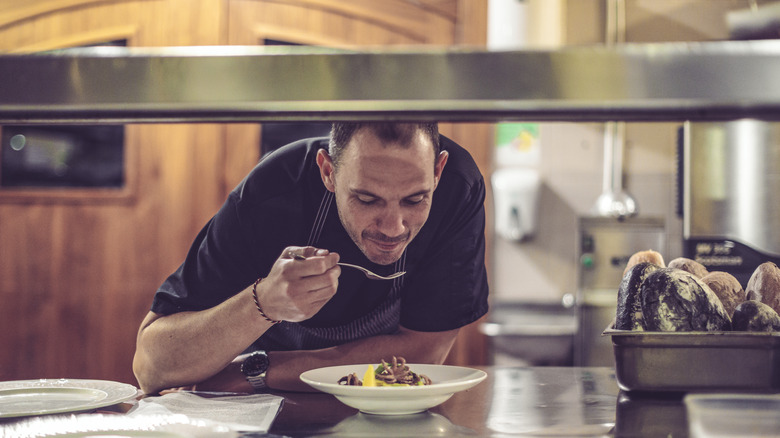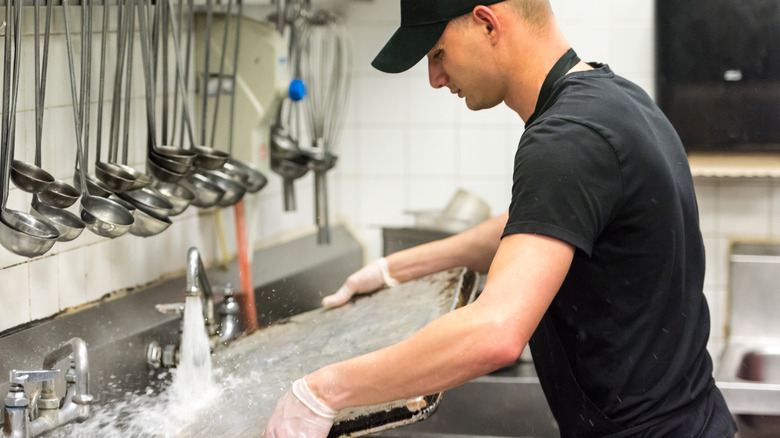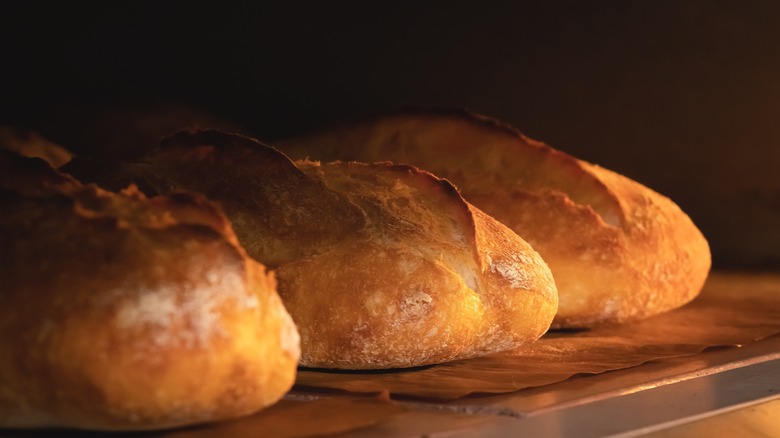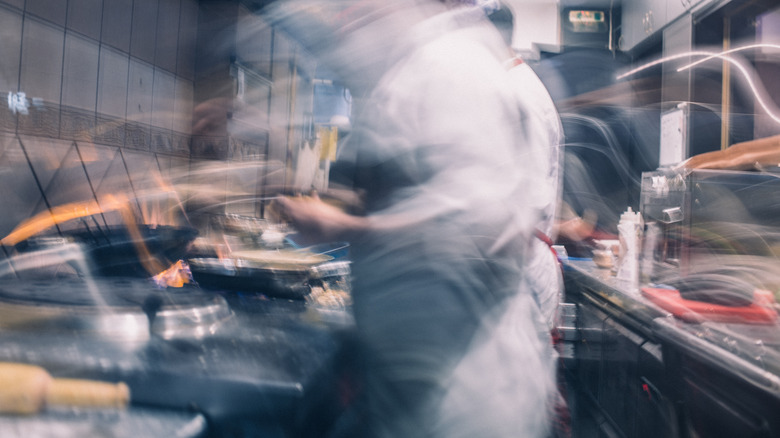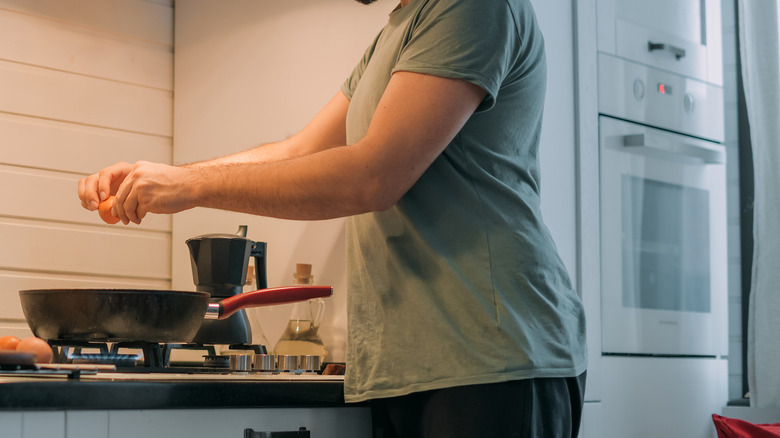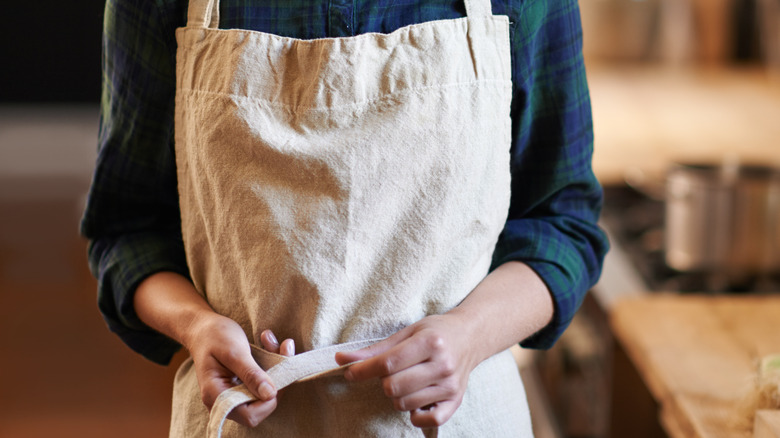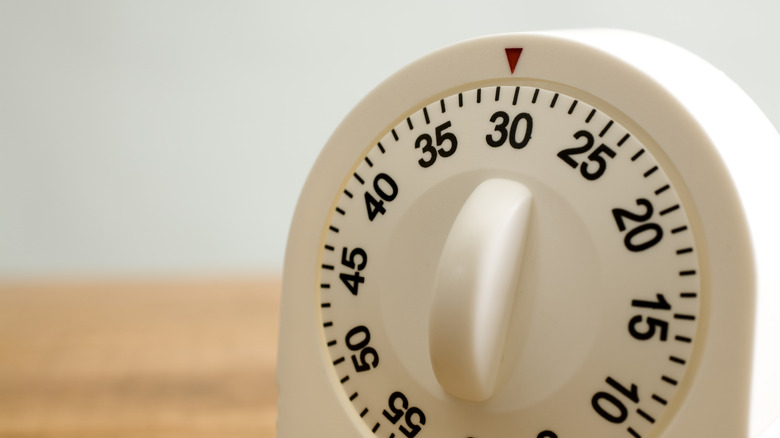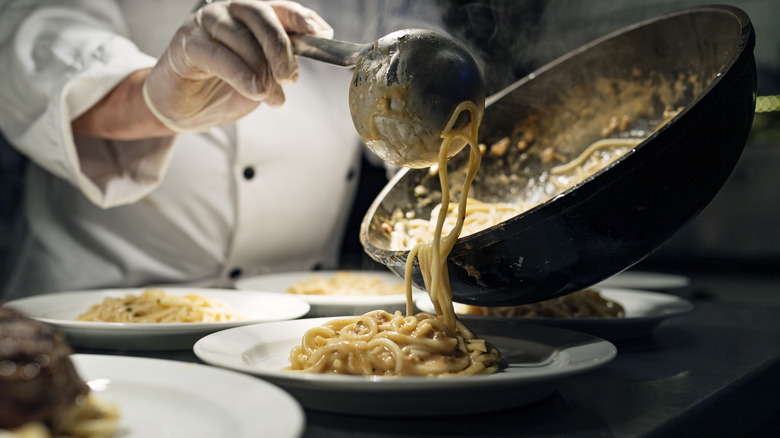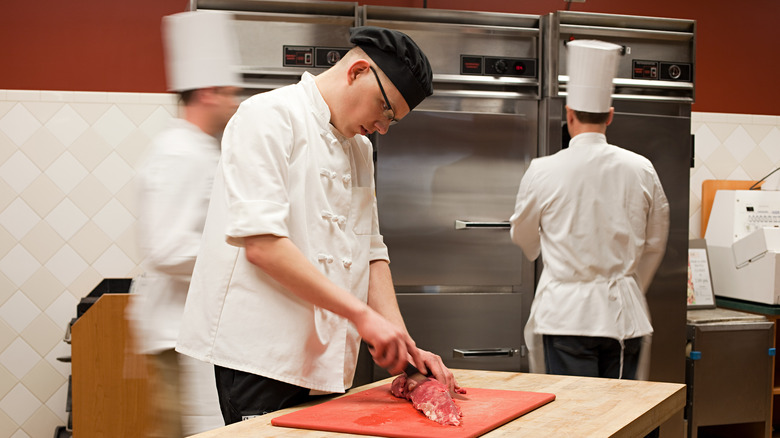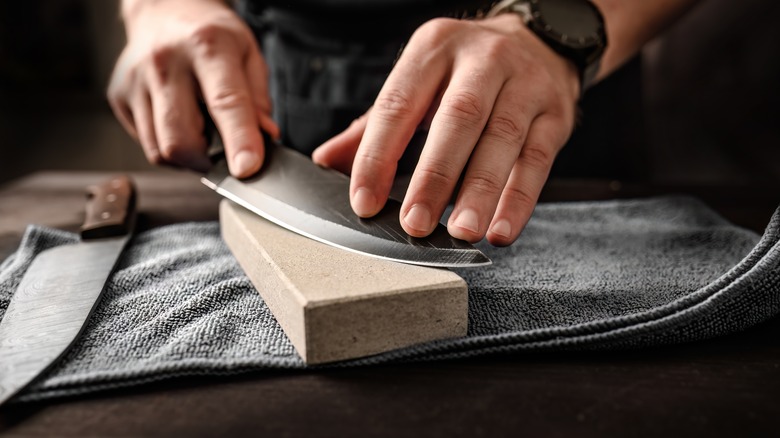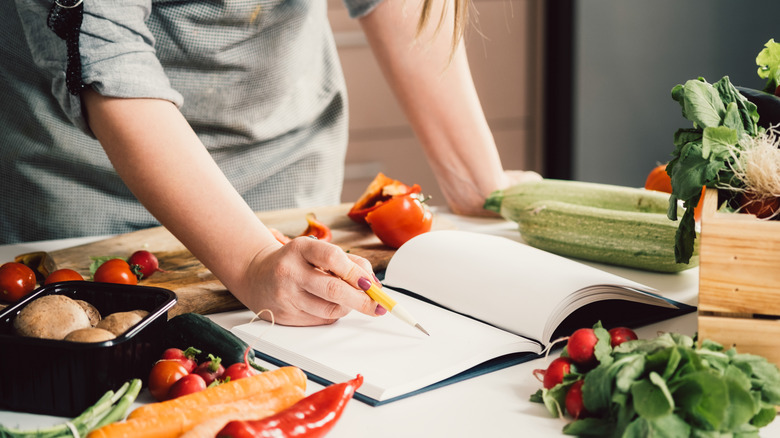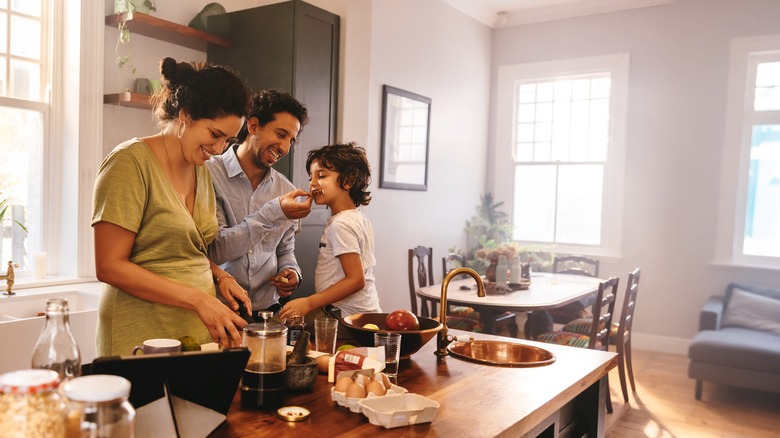17 Cooking Tips That Translate Perfectly From The Fine Dining Kitchen To Home, According To A Chef
Talk to any number of chefs and you may find that not many of them cook for themselves at home unless they have to. It's not a surprise that the last thing we want to do when we get off work, after cooking for strangers all day, is cook for ourselves. It was something I experienced myself as a professional working in restaurants for many years.
After leaving the industry, I found myself integrating what I had learned in a professional kitchen into my home, which made me a better, quicker, and happier home cook. These habits, mentalities, and ways of working in the kitchen have become second nature and are things that any home cook can adopt into their own practice, whether you solely stick to baking or enjoy working over a grill. Following these tips and incorporating them into your cooking routine at home will help you be a more confident home cook and easily translate into the food you prepare.
Prioritize mise en place
Mise en place is among the most common phrases in professional kitchens, especially when associated with the hot grill or a cold appetizer station. It is a French phrase meaning "everything in place." In the kitchen, mise en place translates to "get everything you need to make this recipe and organize it neatly."
When you work in a professional kitchen, you strive every day to have perfect mise en place. That means you have everything you need to execute your job — your tools, ingredients, and prepped items — and enough of all of it. Perfect mise en place means you'll have everything you need to be successful.
When cooking at home, strive for an organized mise en place. Before you start cooking, lay out your ingredients and ensure each is adequately prepped and ready to go. It'll make your cooking experience run seamlessly — from knife cuts to dishwashing. And you'll be much less likely to have to run out to the store in the middle of dinner.
Know thy prep
In the professional kitchen, the time before service is usually reserved to work on prep. Prep, or "preparation," refers to any labor required before actually cooking a complete meal. This could mean chopping vegetables, butchering meat, picking herbs, separating egg yolks, or any sort of repetitious task required before the cooking starts.
Walk into any kitchen outside of service hours, and you'll see a whole team of cooks working diligently to go through prep steps. You'll also probably notice them writing things down and crossing off lists. These prep lists allow cooks to keep track of what they must do for the day.
If you find yourself cooking a complex recipe or cooking for a group of people, make yourself a prep list either on your phone or on paper. Organize the list, starting with the longest or most arduous tasks and ending with the quickest and least time-consuming ones. Cross off the tasks you have completed as you go down the list. You'll be surprised at how organized and efficient your time becomes when you see it on a list. Knowing exactly what you need to do to prepare a recipe will help you organize and maximize the time you spend in the kitchen.
Work clean, work tight
When working in a professional kitchen, it is of the utmost importance to keep every station clean and tidy from when prep starts to when the last plate crosses it. Cooks that work messy — with dirty tools, crumbs and food particles coating everything, and stains and splatters strewn across their workstations — at best, look like slobs and, at worst, risk contaminating their food. Not only do messy cooks attract unwanted attention from the sous chef, but their station is a sign they may not have the organizational skills needed to keep up throughout the shift.
The same can be said for cooking at home. Try to avoid spreading out ingredients, tools, and cookware across the entirety of your counter. Condense your ingredients into the smallest containers possible and organize them neatly around your workspace — even label them if necessary. Keep a clean, wet towel nearby to wipe off your cutting board after each task so that it's not caked with crumbs and debris. Put away any ingredients you're finished using, reassess, and re-organize your space after each prep task is crossed off the list.
Keep towels within reach at all times
One of the most straightforward pieces of advice we can give to home cooks is to stop using oven mitts. Not only are they impractical and unsanitary, but they're impossible to maneuver quickly. If you've ever eaten in an open kitchen, you might've noticed that most of the cooks instead have towels hanging from their aprons to pick up hot trays and pans. These are the preferable, easy-to-reach tools to have in both a professional kitchen and a home kitchen.
We recommend keeping a towel tucked into your apron while you're cooking. It will prevent you from scrambling about to try and grab a potholder from the back of a kitchen cabinet, all while trying to avoid overcooking what's in the oven or on the stove. Do both yourself and your hands a favor and ditch the oven mitts for the much more practical and professional terry towel.
Multitask
All tasks involved in cooking can be categorized as either active or passive. Active tasks require constant attention, be it stirring, cutting, scraping, or any other form of movement. Passive tasks can be started and left to their own devices, such as putting a pot of meat on to simmer for several hours. Nothing would get done on time if all tasks were treated as active tasks in the professional kitchen, which is why multitasking is critical.
In order to make the most efficient use of your time, figure out what tasks are passive and start those first. Once your passive tasks have begun, then you can focus on the active tasks at hand while the passive ones run in the background. For example, if you're making a pizza, grating cheese, picking basil leaves, and slicing salami can all be done while the dough is proofing and tomato sauce is simmering.
Always taste your food
After you learn your kitchen ABCs, you'll learn your ABTs: always be tasting. If you ever had a perfect or near-perfect meal at your favorite restaurant, you probably noticed that every ingredient and every sauce on every plate was perfectly seasoned. This is no coincidence. It's because cooks are obsessed with tasting everything they make from start to finish.
A chef can't taste every dish as a whole as it moves from the kitchen to the dining room. So, the most realistic way to implement quality control is to taste individual components of each menu item. Something as seemingly simple and harmless as an under-salted vinaigrette can ruin an otherwise perfectly good salad, so it's important to know that everything you add to the plate tastes its best.
It's easy to practice your ABTs at home, too. Start by tasting your mise en place to build a working knowledge of food and a Rolodex of flavor profiles. Eventually, you'll know how everything should taste at every cooking stage. When you're assembling the meal and putting on the final touches, ensure you've tasted the sauce being poured, the meat being sliced, and the garnish being sprinkled over the top. This will give you a final sense of what your meal will taste like before you get to eating a finished plate.
Wash as you go
There are few things more disheartening than finishing a beautiful meal and returning to a sink piled high with dirty dishes. Nobody, and I repeat nobody, wants to sit for hours after dinner scrubbing pots and drying plates. Luckily, in a professional kitchen, a team of porters and dishwashers do the cleanup work for us.
This luxury is much less common in the home kitchen, meaning you likely have to wash and put away every pot and pan you use yourself. So, don't leave a pile of work for yourself after you finish cooking. You can mitigate the time you spend doing dishes by cleaning each tool, utensil, pot, and pan right after you use it. By pausing and cleaning a few pieces of cookware, you'll save yourself the arduous task of standing over the sink after the meal and wishing you could just go lay down and digest.
Sandbag the right stuff
Another chef's vocabulary word you might find useful is the term "sandbagging." It's a way to save time by cooking large batches of food ahead of time. This is standard practice in a kitchen, as most food is not made from scratch to order each time. For example, a restaurant that sells hundreds of fried chicken sandwiches daily does not have time to fry a piece of chicken from raw every time an order comes in. Instead, the fry cook will fry off several pieces of chicken at a time and keep the extra pieces in a warm, clean area until an order for another chicken sandwich comes in. When it does, the cook will throw the mostly fried piece of chicken back in the fryer to finish cooking for the order.
You can do this sandbagging technique at home. For example, if you're making French dip sandwiches for a crowd, butter and toast the baguettes ahead of time and pop them in the oven to warm up right before you expect to serve them.
Move with conviction
There is seldom a place for half-stepping in a restaurant kitchen filled to the brim with fire and knives. Uncertain movements and nervous instincts cultivate a hotbed for accidents. In the same way a dull knife is more dangerous than a sharp one, a second-guessing chef is more dangerous than one that moves with conviction.
The reason is this: Nervous, uncertain cooks spill oil on the floor, cut themselves, and accidentally burn other people. The kitchen is no place for jittery, half-baked physical motion. When you open an oven door, open it all the way. The same can be said for working over the stove at home. Similarly, the longer you hold a hot pot in your hands, wondering where to put it, the higher your chance of dropping it. The more you fuss around with a knife, the more likely you are to cut yourself with it.
Do everything in such a way that feels most comfortable for you. Be swift and succinct when handling items and moving back and forth between your tasks. You'll find that by doing this, you'll save time and energy instead of wasting your time second-guessing yourself.
Dress comfy
Have you ever cooked in a three-piece suit or a cocktail dress? If you haven't, you're not missing much. If you have, you know how uncomfortable it is. Chef attire has changed in style over time, but its pragmatism has remained consistent. A cook's garb is designed for utility and comfort above all else. Whether stretchy or oversized, cooking pants, jackets, and even hats are designed for easy movement, protection against high heat and splatter, and breathability in warm kitchens. Kitchen shoes have cushy, non-slip soles to prevent the common heel spur or slick oil slip.
Whatever you choose to wear, make sure you're comfy. Cooking in uncomfortable clothing makes the experience unnecessarily difficult and painful. If you're cooking for an event that requires a specific dress code, start cooking early enough to give yourself time to change between making the meal and bringing it to the function.
Wear an apron
If you don't have an apron, buy one. There's simply no way around it. In short, nothing can substitute for an apron's utility as a splash screen, toolbelt, and towel holder all in one. Professional aprons range from the very basic, pocketless, single-tie dishwasher bib to super sleek double-back-strapped aprons with hidden pockets for tools and utensils.
The best product for you will depend on what you need and how much money you intend to spend. But even the most basic apron can go a long way. Wearing an apron in your home kitchen can save you from splattering oil on your favorite tee shirt or getting a burn on your skin.
If you do choose an apron with extra features, keep in mind that extra pockets go a long way. They can hold writing utensils, thermometers, cell phones, and recipe cards — all of which are within hands' reach.
Set a timer for everything
In any professional kitchen, the bleep-booping, buzzing, and ringing of timers can be heard cacophonously throughout the day, often with a cook or two yelling "Timer!" when the alarm goes on uninterrupted for too long. You might think that with time and experience, the need for timers when cooking food goes away. But no matter how many years of experience you have, you're bound to eventually forget about what you left in the oven if you don't set a timer for it. Memory is a fickle beast, and even the best cooks are not impervious to forgetfulness.
Take it from the professionals: Set a timer for everything you cook, especially if it's out of sight. When baking something of an indeterminate time, set timers at regular intervals to help you avoid overcooking your food. Your phone is your friend for this, but if you like, there are many pro-grade proprietary kitchen timers on the market that work just as well.
Plate your hot food on a hot plate
This one should be pretty obvious, but it's often forgotten about in the kitchen. You should always plate hot food on hot plates and cold food on cold plates. Temperature affects how we perceive flavors and taste ingredients, and there are few things more unsatisfying than lukewarm food that should be piping hot.
Overhead broilers, also known as salamander broilers, are commonly used to quickly sear or crisp food in restaurant kitchens, but they can also be utilized to bring cold plates up to temperature. In your home kitchen, you can rinse your plates under hot water and dry them off before serving. On the other hand, warm or room temperature plates can be tossed in the refrigerator or freezer for a quick chill before plating something like ice cream or salad. Use these techniques at home to prolong the desired temperature of the food you're plating. Keeping your temperatures consistent will level up your food and your attention to detail.
Watch your corners and behinds
You've likely heard the words "corner" or "behind" yelled in a restaurant, in a movie, or on a television show. But we're not just narrating our every move aimlessly around the kitchen. These words play an important role in preventing scalding burns and accidental wounds. It's customary in every restaurant to announce when you turn a blind corner or walk behind a person's back. Doing so lets the other person or people, who ostensibly cannot see you, know that you are there and not run into you or turn around suddenly to bump into you.
While this may sound silly or strange to do at home, there are undoubtedly moments you might find yourself turning a blind corner in a rush or walking past someone holding a knife. When cooking with a partner or friend, use this kitchen slang to prevent collisions and to keep each other safe.
Keep your knives sharp
There's nothing worse as a cook than coming to work with a dull knife. It's a surefire way to make your day harder than it needs to be, whether in the form of crooked cuts or accidental slicing. Dull knives are dangerous. The rounded edge causes them to be imprecise and unpredictable, despite the direction you intend for them to go. This means the edge easily glints and glances off ingredients while cutting, chopping, and slicing, which can cause both inconveniences and injuries.
Home cooks might not prioritize sharpening their knives because it's not a requirement like it is in a professional kitchen. But it should go without saying that you should upkeep your knives regularly, especially if you cook frequently. You can sharpen your knife with a stone or find a local shop that will sharpen your knives for you, but either way, it's important to maintain your most essential tool.
Stay curious
Cooking is all about learning, and the best part about it is that there's always something new to discover. The best cooks in the kitchen are those who know that learning is never done. Reading cookbooks, asking questions, experimenting with new flavors and ingredients, staging in new restaurants, and composing menus and menu items are all ways professional cooks continue to develop their knowledge and skills in the kitchen. Oftentimes, chefs gift younger or more inexperienced cooks cookbooks as gifts to help them learn new techniques and cuisines in their time away from work.
You don't need to go to culinary school or work in a restaurant to learn a lot about cooking. There is a wealth of knowledge available in books and on the internet that can enrich and deepen the foundation of your culinary abilities. Ask questions about how food cooks, buy a vegetable you've never cooked before, cook a whole fish, and eat the parts you usually wouldn't.
Cook because you care
Whether it was a bad day or a good day, professional cooks still have to show up to work to cook again. Although the work can be tiresome, cooks generally care about food and feeding it to people. This is all to say that cooking should not feel like a chore. It should feel like love and joy.
When you're bogged down in the kitchen and things aren't going right, remember why you started and why you took on the task in the first place. If you're doing it out of a feeling of obligation, stop. If you don't know why you're doing it, stop. Cook because you care and want to — not because you have to.
When cooking becomes obligatory, everything about it becomes drab — if not exhausting. The merits and joy it can bring become diminutive and make it painful to continue. Your food will reflect your mood, and you or someone else will taste that mood. And in the end, would you rather taste exhaustion or joy?

